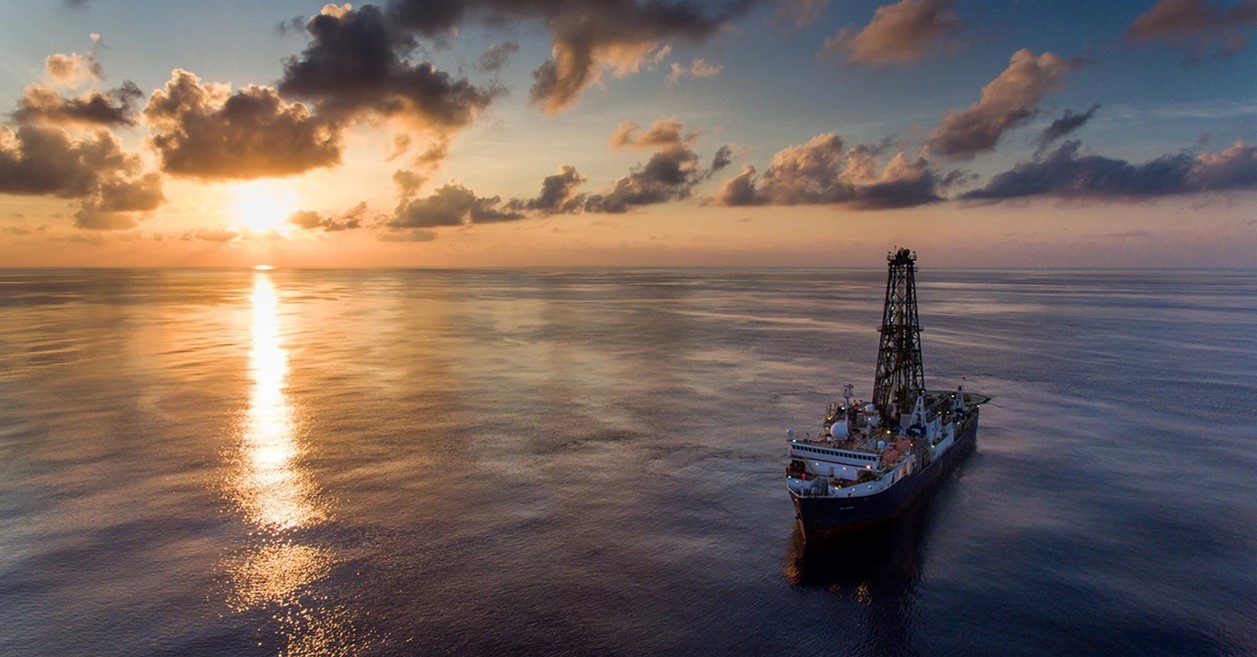
Credit: Shuhao Xie/IODP
For nearly 60 years, an international deep ocean drilling program has revolutionized earth science and understanding.
Two research ships in particular, the Glomar Challenger, later replaced by the JOIDES Resolution, have drilled hundreds of miles of ocean sediment core, in every ocean. These cores provide a record of Earth stretching back millions of years.
They’ve allowed scientists to validate the theory of plate tectonics, study ancient sea creatures, climate and sea level fluctuations, past earthquakes, volcanoes, asteroid impacts, changes in Earth’s magnetic field and more.
And they’ve furthered science in monumental ways. They’ve helped us build the geologic time scale. Make the link between natural orbital cycles and long-term climate variability. Map global ocean circulation patterns to better understand how they warm continents and influence weather.
They’ve shown us that the Mediterranean Sea has completely dried out, several times, and that the Arctic was once subtropical, abounding with warm-water life forms.
They’ve discovered frozen natural gas beneath the seafloor, along with the sunken continent of Zealandia.
In September 2024, the Resolution will be retired, after almost 40 years of service. Smaller European and Japanese ships will keep on drilling, while hopefully the U.S. builds another flagship, to continue the scientific discovery vital to human progress.
Background
Synopsis: For nearly four decades, the JOIDES Resolution has drilled more holes in the ocean floor than any other scientific research vessel, making some of the world’s most important scientific discoveries along the way. In September of 2024 it will be retired, closing the chapter, but not the book, of international deep ocean drilling.
- The JOIDES Resolution is an oceangoing scientific research vessel that travels the globe to drill and core the sediments and rock that lie beneath the ocean floor.
- It was named after the HMS Resolution that Captain James Cook used to explore the Pacific and Antarctic in the 1770s, until his death in Hawaiʻi in 1779.
- The ship was launched in 1978 as an oil exploration vessel called the Sedco/BP 471. It was later outfitted as a state-of-the-art scientific research ship and began working for the Ocean Drilling Program (ODP) in 1985 as JOIDES Resolution.
- JOIDES is an acronym that stands for Joint Oceanographic Institutions for Deep Earth Sampling, a global partnership that provides access to the ocean floor for scientists from hundreds of universities around the world.
- The JOIDES Resolution is also affectionately referred to as “JR.” It is much longer than a football field, with a derrick that rises 203 ft (62 m) above the waterline.
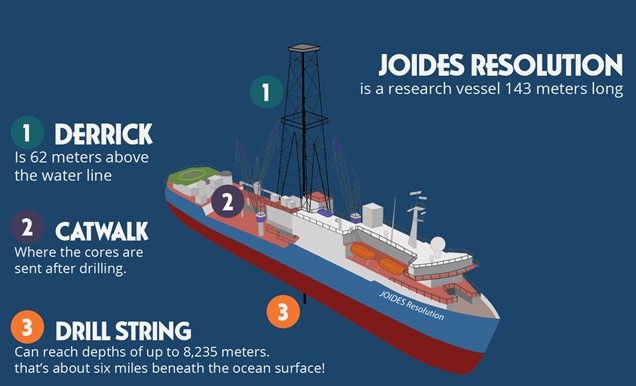
The JOIDES Resolution’s derrick stands 203 ft (62 m) tall, and the ship is longer than a football field at 469 ft (143 m).
Credit: JOIDESResolution.org- This floating earth science laboratory requires a ship’s crew of 70, including marine professionals and ocean drilling specialists.
- In addition to the ship’s crew, each expedition brings its own unique science crew of up to 60 scientists and technicians to analyze core and other data as soon as it is retrieved from the depths.
- During expeditions, science and drilling activities are nonstop, 24 hours a day.
- The deepest hole it has drilled below the seafloor is 6,925 ft (2,111 m), and the deepest water depth to the seafloor it has drilled in is 19,620 ft (5,980 m).
- Each expedition has a specific scientific focus and lasts two months. Between expeditions, the ship goes into port to resupply and reset for each new mission.
- Since 1985, the JOIDES Resolution has journeyed to every ocean basin and made some of the greatest scientific discoveries of our time about Earth’s processes and geological history. Its activities have contributed to ocean drilling technology development, too.
- Since water covers 71% of Earth’s surface, there is a lot we can learn about Earth by exploring below the ocean floor.
- Sediment cores document a “recording” of sequential seafloor deposition resulting from climatic and tectonic changes that cause local and global sea level fluctuations.
- The remains of plants and animals that settle to the seafloor and are buried and preserved help researchers to understand past changes in Earth’s biota and climate, while the chemistry recorded in microfossil shells is a proxy for the conditions of ancient oceans.
- Scientists drill below modern seafloor sediments to learn about the processes that form and destroy Earth’s crust, from subduction zones to asteroid impact craters.
- Scientists study the records of hazards like volcanoes, submarine landslides and earthquakes to protect coastal residents from future events.
- Engineers use what they learn from drilling in challenging ocean environments to develop drilling technology innovations for situations like drilling into highly fractured rock or extremely high temperatures, benefiting commercial drillers.
- Drilling the ocean floor started in earnest when the Deep Sea Drilling Project was born in the 1960s as a United States operation. The effort has since morphed into the longest running, and one of the most successful, multinational collaborative scientific efforts of all time.
- In 1961, not only were the United States and the Soviet Union racing into space, they were also racing to Earth’s mantle. Project Mohole was planned to retrieve a core of Earth’s mantle by drilling through oceanic crust to the Moho (Mohorovičić discontinuity), where an abrupt change in physical parameters marks the boundary between the crust and mantle. While the U.S. expedition failed to reach mantle rocks, the success of dynamic positioning technology at water depths of 11,700 ft (3,566 m) proved that deep sea drilling was possible. The Soviet Union also failed to reach the mantle after drilling onshore for more than 24 years (ED-216 Kola Superdeep).
- For 17 years from 1966 to 1983, when the pioneering Glomar Challenger research ship retired, the first ocean exploration drilling program, known as the Deep Sea Drilling Project (DSDP), included 96 Glomar Challenger expeditions in the Atlantic, Pacific, and Indian Oceans and the Mediterranean and Red Seas, drilling 1,053 holes and collecting 318,425 ft (97,056 m) of core. These DSDP missions provided critical evidence to support the pivotal theory (at the time only a hypothesis) of plate tectonics, including documenting the magnetic striping of the seafloor and formation of new crust at the mid-Atlantic Ridge. These findings revolutionized geological sciences in the twentieth century.
- In 1985, the JOIDES Resolution replaced the Glomar Challenger, recovering over 200 mi (350 km) of deep ocean core in 194 expeditions over 39 years from more than 2,750 drill holes.
- The ODP was also launched in 1985 as an international collaborative effort among 23 nations, replacing the American DSDP. In 111 missions over 18 years (1985–2003), the ODP drilled 1,797 holes and recovered 730,656 ft (222,704 m) of core using the JOIDES Resolution.
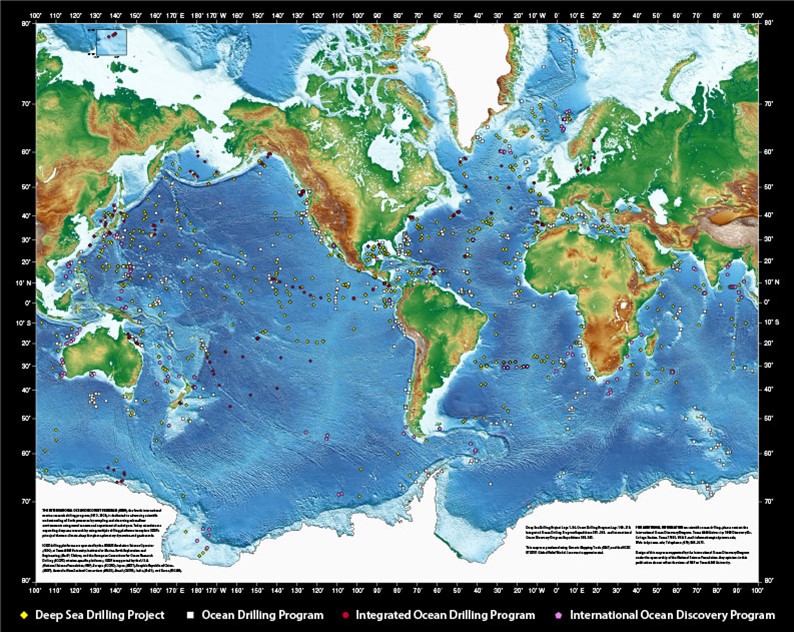
From 1968 to 2023, researchers from around the globe have participated in the Deep Sea Drilling Project (Glomar Challenger), Ocean Drilling Program, Integrated Ocean Drilling Program and International Ocean Discovery Program, traversing Earth’s oceans to answer scientific questions.
Credit: IODP/TAMU - In 2003, the Integrated Ocean Drilling Program (IODP) began, supported for a decade by 26 nations utilizing three types of vessels: a refurbished riserless JOIDES Resolution, a marine riser–equipped Japanese ship called the Chikyū, and specialized vessels for individual expeditions called Mission Specific Platforms. By 2013, 54 IODP expeditions drilled 649 holes and retrieved 217,539 ft (66,306 m) of core.
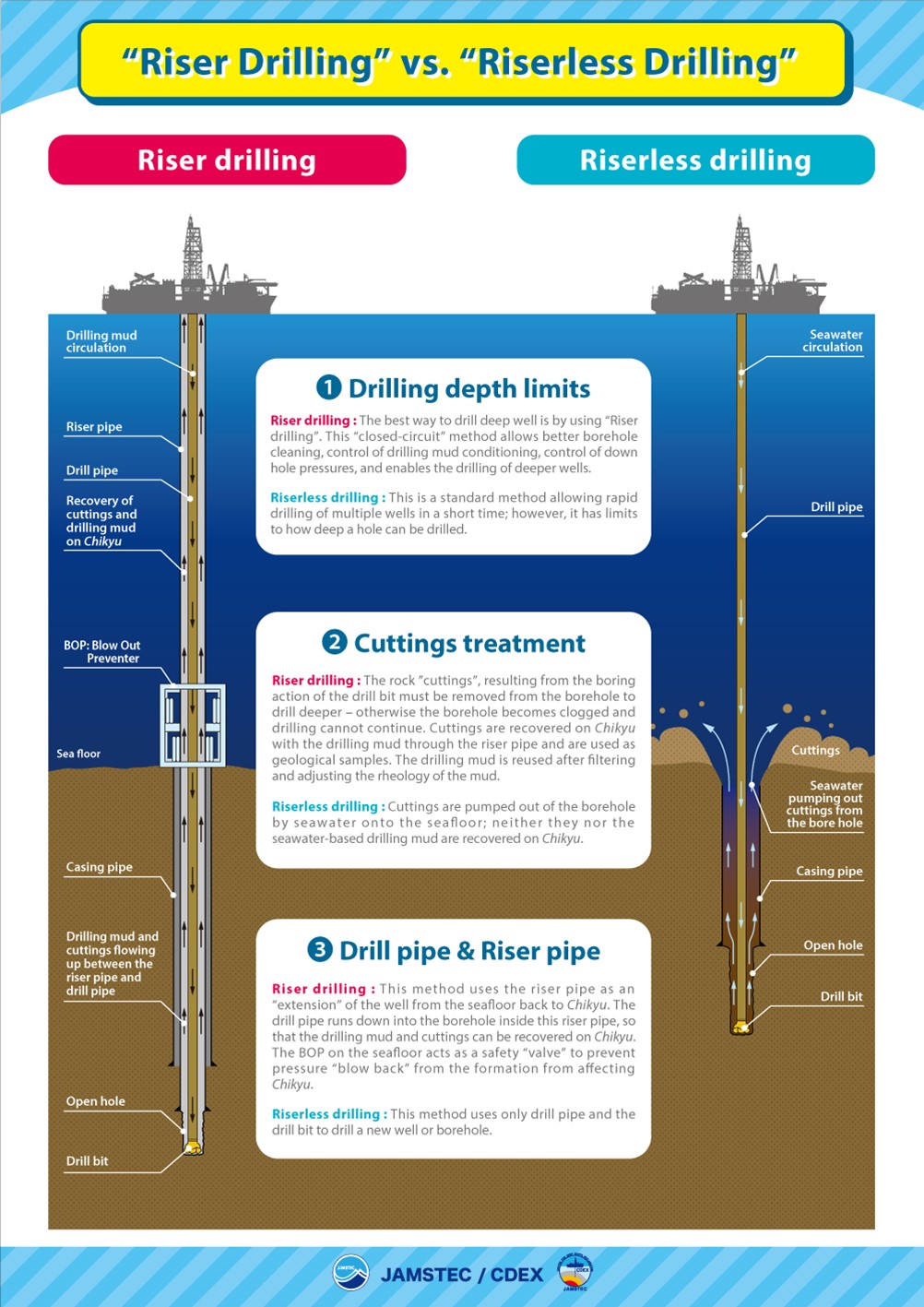
Differences between riserless drilling (like on the JOIDES Resolution) and riser drilling (like on the Chikyū).
Credit: About Chikyū | JAMSTEC - In 2013, the program was renamed the International Ocean Discovery Program (IODP), based at Texas A&M University, and continued as a collaboration between the U.S. National Science Foundation (NSF), the European Consortium for Ocean Research Drilling (ECORD) and Japan. Since 2013, this IODP program added another 56 missions.
- The ODP was also launched in 1985 as an international collaborative effort among 23 nations, replacing the American DSDP. In 111 missions over 18 years (1985–2003), the ODP drilled 1,797 holes and recovered 730,656 ft (222,704 m) of core using the JOIDES Resolution.
- From the time the JOIDES Resolution began drilling in 1985, astonishing earth science discoveries were made by global researchers year after year.
- JOIDES Resolution coring programs augmented the pioneering DSDP investigations of continental rifting, breakup and magmatism as well as illuminating processes that operate at transform boundaries and subducting plate margins.
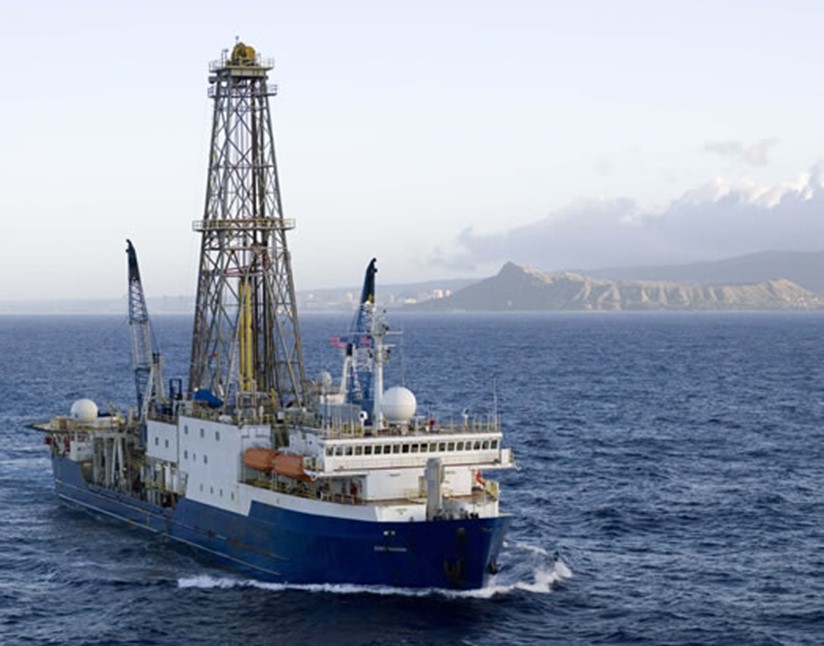
The JOIDES Resolution departing Honolulu, Hawaiʻi.
Credit: IODP, attribution, via Wikimedia Commons - Ocean drilling revealed historical evidence of how volcanoes, earthquakes and tsunamis are generated, and how these dynamic geological processes impact our ocean basins and coastlines.
- Marine microfossils recovered from deep sea sediment cores around the world helped scientists to refine and extend Earth’s geological time scale, and to better understand its climate and sea level history.
- Deep ocean sediment cores provided a record linking Earth’s orbital cycles to long-term climate variability.
- The global extent of core coverage helped scientists to map worldwide ocean circulation patterns.
- Drilling in the Mediterranean found thick, 5 million-year-old salt deposits that indicated the basin dried out repeatedly.
- Core recovered from the Arctic Ocean seabed showed us that the Arctic region was subtropical 55 million years ago.
- Researchers discovered frozen methane hydrates below the seabed and confirmed that these deposits occur throughout the world’s oceans.
- The JOIDES Resolution was instrumental in the investigation of a variety of ocean floor chemosynthetic communities that challenged our notions of the limits of life.
- Deep core recovery revealed that microbes live far below the seafloor within ocean sediments and Earth’s crust at least a mile (1.6 km) below the seafloor, far deeper than life was expected to exist.
- The JOIDES Resolution recently explored the sunken continent of Zealandia in the Indian Ocean, then installed seafloor earthquake monitors near New Zealand to help understand regional earthquake mechanisms and frequency.
- In May of 2023, researchers aboard the JOIDES Resolution drilled into a seamount called the Atlantis Massif and extracted core of mantle peridotites from 4,100 ft (1,250 m) below the seafloor, finally reaching the goal of the 1961 Mohole project.
- However, the JOIDES Resolution was not used for one of the IODP’s most famous expeditions. A mission-specific vessel, the three-legged drilling platform Lifeboat Myrtle, was employed to provide direct evidence of the Chicxulub asteroid impact that ended the Mesozoic Era, when dinosaurs became extinct.
- JOIDES Resolution coring programs augmented the pioneering DSDP investigations of continental rifting, breakup and magmatism as well as illuminating processes that operate at transform boundaries and subducting plate margins.
- Despite this long history of discovery, on March 6, 2023, the U.S. National Science Foundation (NSF) announced the retirement of the JOIDES Resolution, with its final expedition planned for September of 2024.
- The International Ocean Discovery Program (IODP) was already slated for dissolution after its current term ends on September 30, 2024.
- Many researchers had hoped operations on the JOIDES Resolution would be extended until 2028, but the U.S. share of the annual expense was more than the U.S. Congress could support to maintain the 44-year-old ship.
- The last expedition of the JOIDES Resolution, Leg 403, will travel north of Iceland to the Fram Strait, a conduit for currents that flow northward along the western coast of the Norwegian island Spitsbergen from the North Atlantic toward the Arctic Ocean to study the history of sediment drifts shaped by the warm bottom current over millions of years.
- The sheer volume of data that has been collected by the JOIDES Resolution and other scientific research vessels since 1968 provides a detailed global record of the evolution of the ocean basins over millions of years as well as the fundamental processes that operated in them and the life that called them home. But even with all the drilling that has been done, we have barely touched the mysteries beneath Earth’s ocean floor.
- The Resolution carried the bulk of expeditions for the IODP, so the early retirement is a big loss to the global research community, but the NSF plans to fund additional studies on existing core with the funds now freed up. A new U.S. drillship would take more than a decade to build.
- For the future, the remaining partners from the IODP (ECORD and Japan) plan to continue working with global researchers to advance scientific ocean drilling. The 14 European nations and Canada that make up ECORD will use mission-specific vessels, while Japan will use its larger deep ocean drilling vessel, the Chikyū. Continuing in the spirit of the decades-long global collaborative effort, American scientists will, of course, be invited to participate.
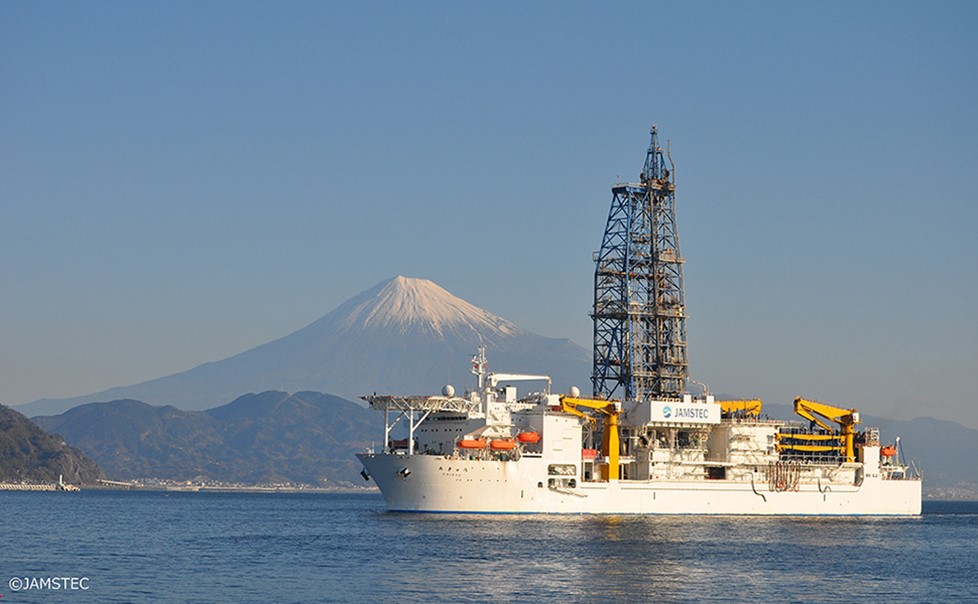
The Japanese ship that will continue in the future IODP program is called Chikyū Hakken, Japanese for "Earth Discovery." It is much larger than the JOIDES Resolution, weighing more than five times as much, with a length of 690 ft (210 m) and a derrick that stands more than twice as tall at 430 ft (130 m) above sea level.
Credit: About Chikyū | JAMSTEC

